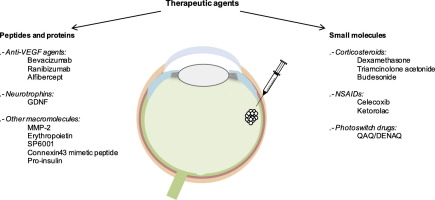Advanced Drug Delivery Reviews ( IF 16.1 ) Pub Date : 2018-01-12 , DOI: 10.1016/j.addr.2018.01.007 Irene Bravo-Osuna , Vanessa Andrés-Guerrero , Alicia Arranz-Romera , Sergio Esteban-Pérez , Irene T. Molina-Martínez , Rocío Herrero-Vanrell

|
Pathologies affecting the optic nerve and the retina are one of the major causes of blindness. These diseases include age-related macular degeneration (AMD), diabetic retinopathy (DR) and glaucoma, among others. Also, there are genetic disorders that affect the retina causing visual impairment. The prevalence of neurodegenerative diseases of the posterior segment is increased as most of them are related with the elderly. Even with the access to different treatments, there are some challenges in managing patients suffering retinal diseases. One of them is the need for frequent interventions. Also, an unpredictable response to therapy has suggested that different pathways may be playing a role in the development of these diseases. The management of these pathologies requires the development of controlled drug delivery systems able to slow the progression of the disease without the need of frequent invasive interventions, typically related with endophthalmitis, retinal detachment, ocular hypertension, cataract, inflammation, and floaters, among other. Biodegradable microspheres are able to encapsulate low molecular weight substances and large molecules such as biotechnological products. Over the last years, a large variety of active substances has been encapsulated in microspheres with the intention of providing neuroprotection of the optic nerve and the retina.
The purpose of the present review is to describe the use of microspheres in chronic neurodegenerative diseases affecting the retina and the optic nerve. The advantage of microencapsulation of low molecular weight drugs as well as therapeutic peptides and proteins to be used as neuroprotective strategy is discussed. Also, a new use of the microspheres in the development of animal models of neurodegeneration of the posterior segment is described.
中文翻译:

微球作为视神经和视网膜慢性疾病的眼内治疗工具
影响视神经和视网膜的病理是失明的主要原因之一。这些疾病包括年龄相关性黄斑变性(AMD),糖尿病性视网膜病(DR)和青光眼等。同样,有些遗传性疾病会影响视网膜,导致视力障碍。后段神经退行性疾病的患病率增加,因为它们大多与老年人有关。即使获得不同的治疗方法,在管理患有视网膜疾病的患者方面仍存在一些挑战。其中之一是需要经常干预。同样,对治疗的不可预测的反应表明,不同的途径可能在这些疾病的发展中起作用。这些病理的管理要求开发可控药物输送系统,该系统能够减缓疾病的发展,而无需频繁的侵入性干预,通常与眼内炎,视网膜脱离,高眼压,白内障,炎症和浮游生物有关。可生物降解的微球能够封装低分子量物质和大分子,例如生物技术产品。在过去的几年中,为了提供对视神经和视网膜的神经保护作用,各种各样的活性物质已经被封装在微球中。可生物降解的微球能够封装低分子量物质和大分子,例如生物技术产品。在过去的几年中,为了提供对视神经和视网膜的神经保护作用,各种各样的活性物质已经被封装在微球中。可生物降解的微球能够封装低分子量物质和大分子,例如生物技术产品。在过去的几年中,为了提供对视神经和视网膜的神经保护作用,各种各样的活性物质已经被封装在微球中。
本综述的目的是描述微球在影响视网膜和视神经的慢性神经退行性疾病中的用途。讨论了微胶囊化低分子量药物以及作为神经保护策略的治疗性肽和蛋白质的优势。而且,描述了微球在后节神经变性动物模型的开发中的新用途。



























 京公网安备 11010802027423号
京公网安备 11010802027423号